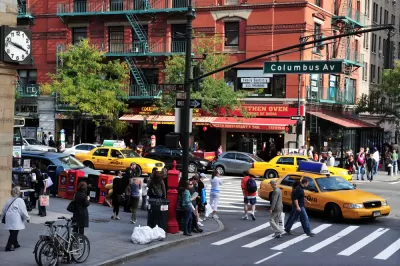The drop in crime in cities has extended American life expectancies, especially those of black men, and brought more wealthy people into urban areas.

American cities have become less violent in few decades, but Patrick Sharkey argues the causes and outcomes of this change are often misunderstood. In terms of the outcomes, falling crime rates have brought wealthy people into areas they had not lived in before and made some towns more tourist-friendly, but more importantly, the decline in violence has had a pronounced effect on American life expectancy, particularly for African Americans. "We found that the national decline in the homicide rate since [1991] has increased the life expectancy of black men by roughly nine months," Patrick Sharkey writes in the New York Times.
What caused this drop in crime is disputed. While Sharkey concedes that some of the drop in crime comes from problematic policing practices that put more Americans in jail, an under appreciated factor in making cities safer was the growth in anti-violence non-profits. "In a typical city with 100,000 people each additional nonprofit devoted to confronting violence led to a roughly 1 percent drop in the city's murder rate," Sharkey writes. He contends that these groups working directly with the community and law enforcement have the capacity to do yet more to curb violence and could be part of "a new model for combating urban violence."
FULL STORY: Two Lessons of the Urban Crime Decline

Maui's Vacation Rental Debate Turns Ugly
Verbal attacks, misinformation campaigns and fistfights plague a high-stakes debate to convert thousands of vacation rentals into long-term housing.

Planetizen Federal Action Tracker
A weekly monitor of how Trump’s orders and actions are impacting planners and planning in America.

In Urban Planning, AI Prompting Could be the New Design Thinking
Creativity has long been key to great urban design. What if we see AI as our new creative partner?

King County Supportive Housing Program Offers Hope for Unhoused Residents
The county is taking a ‘Housing First’ approach that prioritizes getting people into housing, then offering wraparound supportive services.

Researchers Use AI to Get Clearer Picture of US Housing
Analysts are using artificial intelligence to supercharge their research by allowing them to comb through data faster. Though these AI tools can be error prone, they save time and housing researchers are optimistic about the future.

Making Shared Micromobility More Inclusive
Cities and shared mobility system operators can do more to include people with disabilities in planning and operations, per a new report.
Urban Design for Planners 1: Software Tools
This six-course series explores essential urban design concepts using open source software and equips planners with the tools they need to participate fully in the urban design process.
Planning for Universal Design
Learn the tools for implementing Universal Design in planning regulations.
planning NEXT
Appalachian Highlands Housing Partners
Mpact (founded as Rail~Volution)
City of Camden Redevelopment Agency
City of Astoria
City of Portland
City of Laramie



























